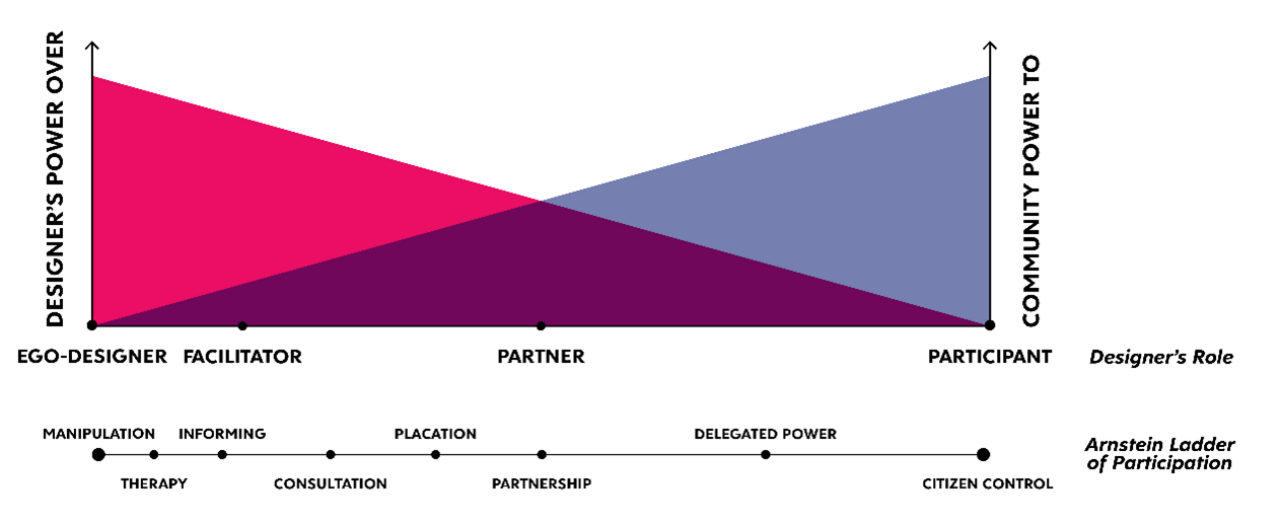Towards a Power-Balanced Participatory Design Process
Participatory designers have taken inspiration from other practices like the social sciences to develop socially just and horizontal processes to collaborate with communities. In their current practice, designers do not always have enough means to address concepts of power and politics in design practice. In their latest paper, Fabiana Tomasini Giannini and PCM Lab director Ingrid Mulder elaborate upon how designers could develop more horizontal relationships within participatory design practices.
As a discipline with the capacity to mediate relationships, design has increasingly been understood as a socially relevant activity supporting societal transformation. In particular, Participatory Design was a big step to democratizing the design practice and opening the space to include the voices of the people intended to use the design outcome.
However, as design practices move to the public domain, the profession fails to understand the ethical complexities of working with a democratic approach, ignoring that involving users in a project leads to addressing issues of politics and power.
Inserted in a complex system and dealing with different stakeholders, designers might have practices, attitudes and assumptions that perpetuate oppression and inequalities inside the design process itself. As such, participatory designers can maintain even unconsciously the same power dynamics they are claiming to change, affecting the more vulnerable in the process.
The study aims to better prepare designers to engage in more power-balanced relationships within participatory projects. For this, six different explorations have been conducted in the neighborhood of Afrikaanderwijk in the south of Rotterdam, looking for horizontal connections with local residents and finding dialogical spaces for re-evaluating the role of the designer inside the process.
The changing role of the designer in power-balanced design processes

The horizontal axis of the framework shows the different roles of the designer. The red color represents the power designers have over the process and other social actors in the project depending on their role. In the role of the facilitator, the designer has more power over the community and the project because in that role designers still have much of the decision making, control over the process, the framing of a problem, etc. When moving to the role of the participant the designer’s power over the community and the project decreases as more agency is given to other social actors. As power is relational and contextual, the less power the designer has in the project, the more power the community is capable of exercising as there are not limited by any design imposition defined by the designer. The community’s power to act is represented in blue in the framework.
If we compare this axis with Arnstein’s ladder of participation the power and agency of the community translate into more citizen control in the process. When understood inside a PD process, the framework shows that the role of the designer may and should change depending on the moment of the project and what the situation requires.
As such, the designer can move between being a facilitator, a partner or a participant depending on the specific moment in the process. This constant re-evaluation of the role of the designer is possible thanks to the dialogue between the community and the designer. Only by creating those dialogical spaces the role of the designer can be re-evaluated and negotiated with the community in mutual understanding during the whole process.
Five propositions supporting participatory designers
The study concludes with five propositions that aim to support participatory designers to be better prepared to establish more power-balanced and accountable relationships when collaborating with communities:
- A power-balanced process is built together with the community.
- For a more power-balanced process, the designer needs to be liberated.
- In a more power-balanced process the designer joins the community to design with them.
- A project for social justice/change is more than what can be framed by design.
- A power-balanced process can be built in reflection and action.
The propositions result in a re-interpretation of the designer’s role as a participant in the context and as a partner with the community.
Read the full paper Towards a Power-Balanced Participatory Design Process’ and/or watch this video to better understand the interactions with the community of the Afrikaanderwijk and the five propositions.
To cite this work please refer to it as follows:
Tomasini Giannini, F. & Mulder, I. (2022). Towards a Power-Balanced Participatory Design Process. In Proc. of Participatory Design Conference 2022: Volume 2 (PDC 2022 Vol. 2), Association for Computing Machinery, New York, NY, USA, 111–117. https://doi.org/10.1145/3537797.3537819
